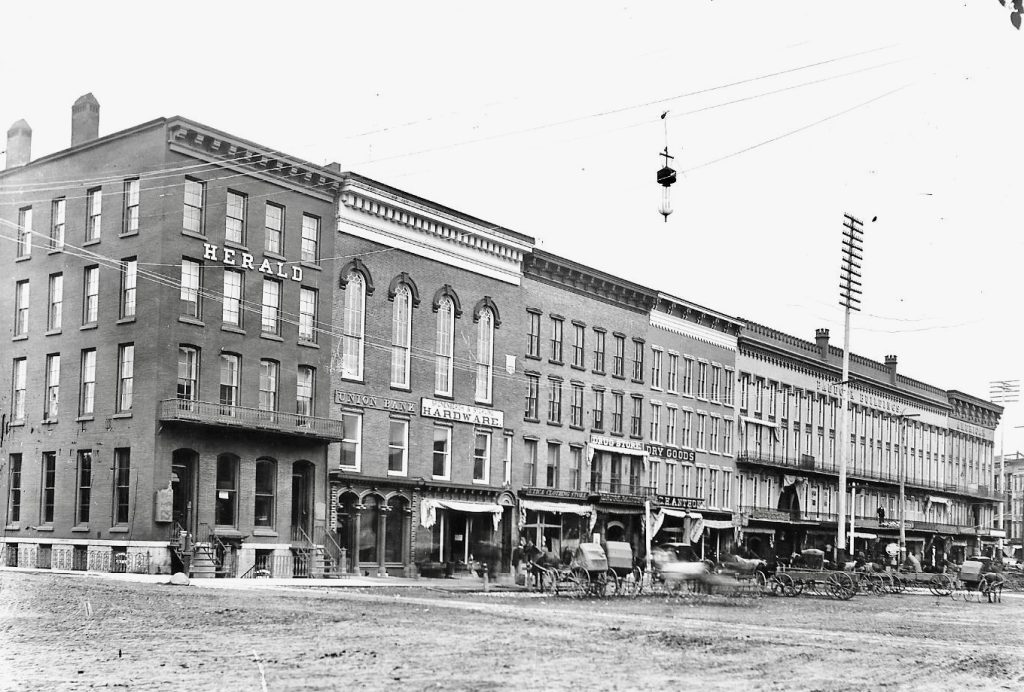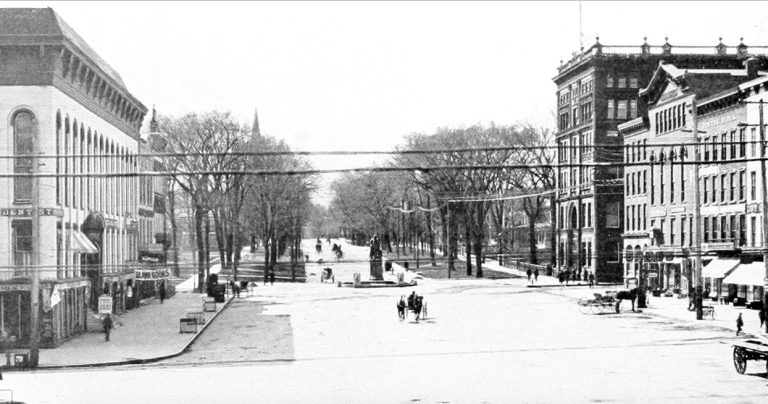The Explosive History Behind the Hungerford Building (aka Smith & Percy)
Located at 104 Washington Street, the former Hungerford building, the name referenced here because of its ownership up until 1969, seems a bit out of place next to the Paddock Arcade and the four-story white shoebox/bomb shelter next to it. From older photos dating back to the turn of the century, all these buildings were of the same height. The history of the Woolworth Building‘s construction is well known, and on that end, the four-story American Building was razed, along with a portion of the Paddock Building, to make way for it. But what happened to this little space next to the Arcade?

The Hungerford ownership dates back to Orville Hungerford, who acquired at least two parcels of the land on which the building sits. The first parcel, dated May 10, 1819, was transferred from Jabez Foster and his wife, Hannah Hungerford Foster, to Orville Hungerford and recorded by the County Clerk’s office on September 1 of that same year. The second parcel was conveyed by Loveland Paddock and his wife Sophia to Orville Hungerford on November 1, 1834, and recorded in the clerk’s office seven days later.
According to The History of Jefferson County, New York, by Samuel W. Durant, published in 1878, Orville started a mercantile business for himself in 1815 after a partnership with Foster. Although its construction date is unknown, the building Hungerford’s business was located in may have pre-existed in the 1815-1819 timeframe. While conducting his business there through 1842, Hungerford dealt with dry goods, cloth, and gloves, many coming from New York City, where he sold his Potash, which led to his decades-long effort to create the Watertown & Rome Railroad.
Surprisingly, the building housing his business survived the Great Fire of 1849—only to burn to the ground soon afterward on October 16, 1852, along with several other buildings that survived within a few years due to several fires. It’s around this time that the third parcel of land was conveyed, this time from Orin C. Utley and wife Catherine, to Richard E. Hungerford, son of Orville, who died in 1851, dated March 21, 1853, and recorded in the clerk’s office on March 22, 1853.

The erection of the Hungerford Building, often referred to as the Hungerford Block, is not to be confused with the building of the same name that stood on Court Street. The building would become the four-story equivalent to those surrounding it and become home to a dry goods store and, as reported in the May 24, 1855 edition of the New York Reformer—
Great excitement in Watertown, caused by a wonderful discover, at the New Hat, Cap & Fur Store of Israel M. Cohen, no 3, Hungerford’s Block, Washington Street, third door south of the Arcade entrance.
Israel takes pleasure in informing the citizens of Watertown and vicinity, that he has made a discovery by which he is enabled to sell the best quality of Lenin’s, Leary’s and Beebee’s fashionable and Elegant hats fifty cents cheaper than ever offered by any other establishment in Northern New York, and all other goods in his line as cheap in proportion.

The new Hungerford Building would stand for nearly 80 years before the unthinkable occurred.
Blaze, Following Terrific Explosion In Hungerford Estate Building, Extends From Trust Company to Woolworth Block—Three Buildings and Paddock Arcade Damaged
So read the headlines of the June 15, 1932, Watertown Daily Times, followed by—
A terrific explosion in the Sample Suit Shop over Smith and Percy’s store, which hurled window glass and furnishings across Public Square as far as the Y.M.C.A building, was followed by one of the worst fires in the history of the city at 11:15 Tuesday night, and early this morning as firemen were still pouring water on the ruins of the Hungerford block, the total damage was estimated by business men at approximately half a million dollars.
Two persons were injured, neither seriously. A towering wall of flame quickly swept the adjoining Powers building, the Paddock building, and the Arcade. The cause of the explosion was a mystery, but firemen believed that a gas used by Ralph Hodgen, owner of the Sample Suit Store, had seeped through the building and ignited.

The article went on to mention the explosion occurred at 11:15 p.m., shattering glass at both the front and rear of the Hungerford building and sending four-clothed dummies and a tabletop blown nearly across Washington Street. Thousands reportedly descended upon Public Square to watch the fire, which could be seen from miles away.
Damage included the Hungerford Building, which was gutted. Partial burning of the upper two floors and the attic of the Powers building. Burning of part of the Paddock building. Burning of a portion of the top of the Paddock Arcade. The total destruction of the Smith & Percy dry goods store, Sample Suit Parlor, and Nannette Beauty Parlor. The orange lodge rooms were destroyed on the third and fourth floors of the Hungerford Building, and partial destruction of stores on the second floor of the Paddock Arcade.

After the fire was discovered, the second, third, and fourth floors of the Hungerford building collapsed. Every store in the Paddock Arcade suffered smoke and water damage, including: Elkhorn Market, Card Shop, Booras Confectionary, Thomas News Shop, and a vacant store formerly occupied by the Karmelkorn company. Morgan Jewelry, Car & Wallis, Clothiers; Herrick Drug Co.; MacRae & Grappotte, Shoe Store; Arcade Barber Shop, Postal Telegraph and Travers’ Cigar Store.
On the second floor: Carolyn-Elizabeth shop; Pinsonneault Millinery; Spies Beauty Shop, a vacant store; and Fannie Shean’s dressmaking and novelty shop. These suffered the most damage. Carolyn-Elizabeth Children’s Shop, Dr. D. B. Armstrong’s Office, Flanigan’s Tailor Shop, Trustee’s Office, Robt. Flaws’ tailor shop and the Coffee Shop, all on the second floor, were lessor-damaged businesses.

The initial suspicion that the building blew up due to a gas leak was later confirmed when witnesses in the vicinity reported they had smelled it moments before the explosion. Fortunately, the Richard S. Hungerford estate, Orville’s grandson, was managed by the Jefferson County National Bank, which was its trustee and was fully insured. When the younger Richard died in 1919, he made arrangements in his will that, should the Hungerford Building be damaged or lost, it must be repaired or rebuilt as the circumstances warranted.

Within several days, it was announced that a modern building would be erected to replace the Hungerford building, with extensive repairs and alterations made to the other damaged properties. That same day, the front wall of the Hungerford building, all that still stood, was condemned by the city engineer who ordered it razed as quickly as possible.
The building at the time of the explosion was leased by Smith & Percy, Inc., dry goods merchants who signed on as tenants in the new building. “As the circumstances warranted,” turned out to be a structure only two stories tall. This was because it was determined the rental values for two additional floors were deemed inadequate.

Under the will of Richard S. Hungerford, the beneficiaries of the trust creating the new building, the official addresses being 104-106 Washington Street, were Mrs. Ida Hungerford Wise and her son, Lieutenant Richard Wise, United States Army, of Watertown. Lieutenant Wise was the grandson of Richard S. and Adella Babcock Hungerford, two of the most prominent families of Watertown, and spent his early life growing up there.
A year after Lieutenant Wise’s death in 1968, the property was sold by several descendants to Smith & Percy, Inc. The property passed to Slye/Burrows in 1994, then Watertown RX LLC, in 2006. Its most recent sale, in June of 2022, was for over $1.1 million to Downtown Professional Buildings, LLC.






















